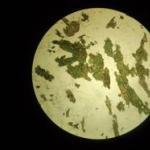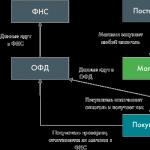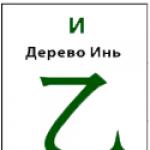Goods are placed under the customs regime of re-import if. Customs re-import procedure. Package of necessary papers
The placement of re-imported goods into re-import is accompanied by a number of conditions that are contained in Article 293 of the Labor Code of the Union.
First of all, this article lists the customs procedures that accompanied the export of goods from the customs territory of the union, which subsequently allow the use of re-import.
These procedures are:
- -export;
- - processing in the customs territory, if processed products were exported;
- - temporary export;
- -processing outside the customs territory, if goods are imported that have not been subjected to processing operations, or products of processing of goods that were exported for the purpose of processing for free (warranty) repairs.
Placing goods under the re-import procedure is possible if a number of conditions are met:
- 1) when exported from the customs territory Russian Federation the goods were in free circulation or were products of processing of foreign goods;
- 2) goods are declared for the re-import procedure within three years after they cross the customs border during export; this period can be extended under certain circumstances, which will be discussed below;
- 3) the goods are in the same condition in which they were exported from the customs territory of the Russian Federation, with the exception of changes that occurred due to natural wear and tear or natural loss under normal conditions of transportation, storage or use (operation);
- 4) the amounts of import taxes have been paid customs duties, taxes, subsidies and other amounts subject to return to the federal budget upon re-import of goods.
Goods that cannot be placed under the re-import regime include :
- ·foreign goods;
- · Russian goods exported from the customs territory of the Customs Union in accordance with types of customs regimes other than the export regime;
- · Russian goods that, although they were exported in accordance with the export regime, are re-imported after the expiration of the established deadlines for re-import;
- ·goods prohibited for import into Russia and export outside its borders in accordance with Russian legislation.
Paragraph 2 of Article 293 of the Labor Code of the Union provides for the possibility of establishing a period exceeding three years by decision of the Customs Union Commission. In order to implement this provision, the Decision of the Customs Union Commission dated September 20, 2010 N 375 “On some issues of application of customs procedures” defines categories of goods for which the period of placement under the re-import procedure may exceed the period established by the Labor Code of the Union, which includes goods used for construction, industrial production, mining and other similar purposes, as well as goods exported in the export procedure, to ensure the functioning of embassies, consulates and other official representative offices of the member states of the Customs Union outside the customs territory of the union, in respect of which, in accordance with the legislation of the member states of the Customs Union Union decided to extend the period for placing these goods under the re-import procedure. Thus, the Commission's decision defines the purpose of the export of goods.
The procedure for extending the period for re-importation of goods in the case under consideration is established by the Federal Law “On Customs Regulation in the Russian Federation” (Article 286). To extend the period, the declarant, no later than 30 days before the day of declaration of goods, sends a reasoned request to the federal executive body authorized in the field of customs affairs , i.e. to the Federal Customs Service. The request must set out the circumstances of the export of goods, accompanied by the customs declaration that accompanied the export of goods, as well as documentation :
- 1) confirming circumstances of the export of goods;
- 2) testifying to the date the goods crossed the customs border of the union;
- 3) containing information about operations for the repair of goods outside the customs territory of the union, if they were carried out.
The request is considered within no more than 30 days, under certain conditions or more, for example, when not all necessary documents are submitted. In this case, the request is considered within 15 days from the date of their submission.
Noteworthy is the provision of Article 286 of the Law, according to which the decision to extend the period for re-import of goods is made by the head of the structural unit of the Federal customs service, whose competence includes issues of application of customs procedures, or a person replacing him. The decision to extend the period must be brought to the attention of the declarant and the customs authority in the region of whose activity the declaration of goods for re-import will be carried out.
In addition to the procedures for export and processing in the customs territory, goods can be exported under the temporary export procedure, in which case they must be imported back within the period of temporary export.
Goods placed under the processing procedure outside the customs territory must be imported back within the processing period.
At the same time, re-import in the re-import procedure of previously exported goods in the temporary export procedure is possible subject to a three-year period, only in this case the re-import is exempt from paying customs duties and taxes. To comply with this condition, the interested enterprise must import previously exported goods before the expiration of the specified period.
If the three-year period is not met, the enterprise concerned must place the “re-imported” goods under the procedure of release for domestic consumption, which requires payment of customs duties, taxes and compliance with all restrictions established by the legislation on government regulation externally trading activities, i.e. We are talking about additional costs.
Another necessary condition for placing back imported goods under the re-import procedure is unchanged condition of goods (only changes caused by natural wear and tear that occur under normal conditions of use (operation) or transportation and storage are taken into account).
It should also be noted that the condition of the goods may change under other circumstances. For example, during loading and unloading, as a result of incorrect actions, the goods were damaged, including to the point of impossibility of operation. Such circumstances may arise before the goods are delivered to a foreign customer, i.e. the supplier has an obligation to deliver new product or carry out repair operations to restore damaged goods. Damaged goods, as a rule, must be returned to the supplier, since, depending on the nature of the damage, restoration work only possible at the manufacturer's facility. The return of damaged goods can be carried out in the procedure of release for domestic consumption, which, as a rule, the customs authorities insist on, but then it is necessary to pay customs duties, taxes and comply with all restrictions established by the legislation on state regulation of foreign trade activities.
In a similar way, the identity of goods previously exported in accordance with the export procedure and goods placed under the re-import procedure, the fact and time of their export, as well as the fact that the goods are Russian, must be established (confirmed). The burden of proving these circumstances rests with the interested party.
As a rule, confirmation of these circumstances, in particular the fact and moment of export of goods, is customs declaration. If it is absent and if the date of export is not confirmed “in a way that does not raise doubts,” the moment of export of goods of Russian origin (before December 31, 1991 - USSR) is considered the day of manufacture of the goods. In the absence of documents indicating the day of manufacture of the goods, an examination may be carried out.
Article 292. Contents of the customs procedure for re-import
1. Re-import is a customs procedure in which goods previously exported from the customs territory of the Customs Union are imported back into the customs territory of the Customs Union within the time limits established by Article 293 of this Code without paying import customs duties, taxes and without applying non-tariff regulation measures.
2. Goods placed under the customs procedure of re-import acquire the status of goods of the Customs Union, with the exception of the goods specified in subparagraph 4) of paragraph 1 of Article 293 of this Code, which are products of processing of goods exported from the customs territory of the Customs Union in accordance with paragraph 3 of Article 253 of this Code.
Article 293. Conditions for placing goods under the customs procedure of re-import
1. Previously exported goods may be placed under the customs procedure of re-import:
1) placed under the customs procedure for export or being products of processing of goods placed under the customs procedure for processing on the customs territory, and exported from the customs territory of the Customs Union in accordance with the customs procedure for re-export, if:
these goods are placed under the customs procedure of re-import for 3 (three) years from the day following the day of their movement across the customs border when exported from the customs territory of the customs union or within another period established in accordance with paragraph 2 of this article;
these goods are in an unchanged condition, with the exception of changes due to natural wear and tear or natural loss under normal conditions of transportation (shipment), storage and (or) use (operation);
documents have been submitted to the customs authority in accordance with Article 294 of this Code;
2) placed under the customs procedure of temporary export, if these goods are imported during the period of temporary export and are in the same condition with the exception of changes due to natural wear and tear or natural loss under normal conditions of transportation (shipment), storage and (or) use (operation) , as well as changes that are allowed in relation to such goods when they are used in accordance with the customs procedure for temporary export;
3) placed under the customs procedure of processing outside the customs territory, if these goods are imported during the processing period and are in the same condition in which they were exported from the customs territory of the Customs Union, with the exception of changes due to natural wear and tear or natural loss under normal transportation conditions (transportation), storage and (or) use (operation);
4) being products of processing of goods placed under the customs procedure of processing outside the customs territory, if the purpose of processing was gratuitous (warranty) repairs and these goods are placed under the customs procedure of re-import during the processing period, with the exception of products of processing of goods, upon release of which under the customs procedure release for domestic consumption, the presence of a defect (defects) that was (were) the reason for the free (warranty) repair of these goods was taken into account.
2. Regarding individual categories goods, by decision of the Customs Union Commission, periods may be established that exceed the period specified in subparagraph 1) of paragraph 1 of this article.
3. When re-importing, compensation, taxes and (or) interest on them, when the amounts of such taxes and (or) interest in connection with the export of goods from the customs territory were not paid or were returned, as well as amounts of other taxes, subsidies and other amounts, not paid or received directly or indirectly as payments, benefits or compensation in connection with the export of goods from the customs territory, is carried out in the manner and under the conditions established by the legislation of the member states of the customs union.
When re-importing, reimbursement of import customs duties, when the amounts of such duties in connection with the export of goods from the customs territory were not paid or were returned, is made in accordance with the international agreement of the member states of the customs union.
4. The declarant of the customs re-import procedure may be a person who was a declarant of one of the customs procedures specified in paragraph 1 of this article, in accordance with which goods were exported from the customs territory of the customs union.
The customs legislation of the customs union may establish cases when another person may act as a declarant of the customs re-import procedure.
5. Goods are placed under the customs procedure of re-import in a member state of the customs union in which they were placed under one of the customs procedures specified in paragraph 1 of this article.
Article 294. Documents and information necessary for placing goods under the customs procedure of re-import
1. To place goods under the customs procedure of re-import, the declarant submits to the customs authority information about the circumstances of the export of goods from the customs territory of the customs union, as well as information about operations for the repair of goods, if such operations were carried out with goods outside the customs territory of the customs union.
2. To confirm the information specified in paragraph 1 of this article, the declarant submits a customs declaration accepted upon export of goods and documents confirming the date of movement of goods across the customs border upon their export.
Article 295. Refund (offset) of amounts of export customs duties
In relation to the goods specified in subparagraph 1) paragraph 1 of Article 293 of this Code, placed under the customs procedure of re-import, a refund (offset) of the paid amounts of export customs duties is made if the specified goods are placed under the customs procedure of re-import no later than 6 (six) months from the date , following the day of placing such goods under the customs export procedure.
1. The conditions for placing goods under the customs procedure of re-import are:
2) submission to the customs authority of information about the circumstances of the export of goods from the customs territory of the Union, repair operations, if such operations were carried out with goods outside the customs territory of the Union and are confirmed by the submission of customs and (or) other documents or information about such documents;
2. The conditions for placing goods previously exported from the customs territory of the Union, in respect of which the customs export procedure was applied, under the customs re-import procedure are:
1) placing goods under the customs procedure of re-import before the expiration of 3 years from the day following the day of their actual export from the customs territory of the Union, or before the expiration of another period determined by the Commission in accordance with paragraph 3 of this article;
2) maintaining the unchanged state of goods in which they were exported from the customs territory of the Union, with the exception of changes due to natural wear and tear, as well as changes due to natural loss under normal conditions of transportation (shipment) and (or) storage;
3) reimbursement of taxes and (or) interest on them, when the amounts of such taxes and (or) interest in connection with the export of goods from the customs territory of the Union were not paid or were returned, as well as amounts of other taxes, subsidies and other amounts unpaid or received directly or indirectly as payments, benefits or compensation in connection with the export of goods from the customs territory of the Union, if provided for by the legislation of the Member States, in the manner and under the conditions established by such legislation.
4. The conditions for placing goods previously exported from the customs territory of the Union, in respect of which the customs procedure of temporary export was applied, under the customs procedure of re-import are:
1) importation of goods into the customs territory of the Union during the period of validity of the customs procedure for temporary export;
2) maintaining the unchanged state of goods in which they were exported from the customs territory of the Union, with the exception of changes due to natural wear and tear, as well as changes due to natural loss under normal conditions of transportation (shipment) and (or) storage, as well as changes that are allowed in in relation to such goods when they are used in accordance with the customs procedure for temporary export.
5. The conditions for placing goods previously exported from the customs territory of the Union, in respect of which the customs procedure of processing outside the customs territory was applied, under the customs procedure of re-import are:
1) importation of goods into the customs territory of the Union during the period of validity of the customs procedure for processing outside the customs territory, established by the customs authority;
2) maintaining the unchanged state of goods in which they were exported from the customs territory of the Union, with the exception of changes due to natural wear and tear, as well as changes due to natural loss under normal conditions of transportation (shipment) and (or) storage.
Re-import is a procedure in which goods are imported into a country that were previously exported from its territory.
They should not have been repaired or modernized on foreign territory, and the reason for return may be identified defects or illiquidity of the goods.
In other words, this is a process when they wanted to sell the goods abroad and even took them out of Russia, but for one reason or another they returned them back. Taxes and fees that are required to be paid when transporting goods across the border are not paid in this case.
When applying this procedure, there is no payment of customs duties, and the goods themselves become classified as goods of free circulation.
In accordance with current legislation, this customs procedure belongs to the final group and represents the final stage of the process of moving goods previously exported from the territory of Russia. At the final stage, the cargo is returned back to the customs territory of the Russian Federation.
Conditions for placing goods in the re-import process
In accordance with current customs legislation, products that meet the following criteria may be placed under the procedure:
- The products were intended for export, either processed products or re-exported goods, provided that the re-import process began no later than three years after the goods crossed the border. Products must be in their original condition, with the exception of natural loss provided for under correct storage and transportation conditions. Of course, all relevant, correctly drawn up documents must be provided to customs.
- The products are in the process of temporary export, provided that the deadlines are met and the condition of the goods remains unchanged.
- Cargo undergoing processing outside the customs territory. The main condition here is also the original condition of the goods, which must remain unchanged, only natural losses provided for under the conditions of storage and transportation are allowed.
- Products obtained after processing goods outside the customs territory. However, only if the processing was carried out for free or warranty purposes.
The current Customs Code clearly states under what conditions products can be placed under the re-import process.

Required documents
What documents are required when completing the customs procedure? First of all, the owner or carrier of the cargo must provide customs information about how and under what circumstances the goods crossed Russian border. Information about the repairs performed is also required if it took place outside the Russian Federation.
As supporting documents, a declaration is submitted, which was drawn up for this cargo at the time of departure from Russian territory, documents indicating the day of crossing the state border at the time of departure, as well as other papers that can confirm the accuracy of the stated information.
Conditions for refund of export duties
- It is possible to return the previously paid amount of customs duties only if the cargo is returned to the territory of the Russian Federation no later than six months after crossing the border in another direction.
- The return occurs after the owner or carrier submits a correctly completed application to customs, with documents attached confirming the rights to the product, as well as the fact of crossing the border. If there are other documents confirming the accuracy of any information specified in the application, they should also be attached to the application.
- In the event that customs returns the entire package of documents without consideration or decision, the owner of the cargo has the right to re-submit an application for a refund of paid duties.
- Refunds are made only in rubles and only by bank transfer.
Grounds for refusal

Of course, the Customs Code also provides for a number of cases when the customs authority has the right to refuse a person who has filed a request for a refund.
- The person who submitted the application and the one who paid customs duties are two different individuals who are not successors to each other.
- Application deadlines have been missed.
- The signature on the application was affixed by a person who does not have the appropriate official authority.
- The information specified in the application is unreliable, or does not contain enough information confirming the fact of export of cargo abroad, or any other essential information.
- The paid duties were not credited to the Treasury account or did not pass through the customs office.
- The person who submitted the application has a debt to the budget to pay other customs duties. In this case, the amount of this debt is withheld, and the remaining amount is returned.
The essence of the re-import process

So, re-import is quite widespread in the region foreign trade, since in reality very often situations arise that require the return of cargo back to the territory of the state from which it was previously exported. In the Russian Federation, the legal side of the issue is reflected in the Customs Code, as well as in Federal law“on customs regulation...”
Re-import can be an independent process, or it can be the final part of other procedures, such as temporary export. This implies that the products were exported from Russian territory for an indefinite period, and then returned back.
In the event that goods were intended for export, safely left the territory of Russia, and then certain circumstances emerged requiring their return, then re-import will be a separate procedure not related to export, since the export process was completed from the moment the cargo crossed the Russian border .
IN legal aspect products in the process of re-import are considered goods for free circulation, in other words, on the territory of the Russian Federation these products can be in circulation without any restrictions.
The key point is the absence of customs duties, which are otherwise mandatory and constitute a significant share of the carrier’s costs.
There are a number of conditions that must be met if goods are placed under the re-import procedure. They are all listed in the Customs Code.
- First, a number of other processes are listed after which the cargo can be declared as re-imported.
- Another condition is the condition of the products. It must be original and unaltered except for normal wear and tear. However, the condition of immutability does not apply to products of processing of goods exported during processing outside the customs territory for the purpose of free repair. This is due to the fact that during repairs, of course, the condition of the product changes.
- It is mandatory to provide customs documents containing information about the fact that the cargo has left the territory of the state. As a rule, this is a customs declaration, but there may also be other documents containing information about when and how the cargo crossed the border.
- It is noteworthy that the list of documents is not too wide. A rather vague wording about “other documents” can lead to many questions about whether a license or a contract and the like are suitable here.
When considering the conditions for applying a re-import procedure to cargo, it is worth paying attention to the requirement about the condition of the product. The Code states that only natural loss that occurs during compliance with the conditions of transportation and storage is allowed.
However, the condition of the cargo may change due to, for example, incorrect actions during loading. This can happen before the goods are transferred to the customer, in other words, the owner faces the need for repairs or prompt delivery of a new product.
There are situations when a damaged product must be returned to the supplier, since the damage received can only be repaired at the manufacturer. And when applying the re-import procedure to such cargo, customs may have questions related to the requirement of unchanged condition. As a rule, authorities insist on the application of a release procedure for domestic use to such products, which entails the need to pay customs duties.
The Customs Code introduces a restriction on the list of customs authorities where cargo can be declared as subject to re-import; this is possible only in the country of the Customs Union where the previous customs process began.
As mentioned above, when re-importing there is no payment of import duties, but at the same time in this process there is a refund of taxes when such an amount was not paid, or was returned, or was subsidized.
For example, in the process of exporting goods, an exemption from paying VAT is provided, a subsidy is received as part of supporting the exporter, and interest on the loan is reimbursed. Thus, in the process of re-importing goods, the owner of the goods returns to the starting point.
The Customs Code provides for two algorithms for the reimbursement of duties and other payments. However, despite the fact that the procedure is regulated in sufficient detail by legislative documents, questions inevitably arise when carrying out trading activities.
Is it possible to declare as re-imported goods part of the cargo that previously left the territory of Russia? Or is it possible to apply this procedure to goods held in a customs warehouse after their return to Russian territory from abroad?
Re-import is a complex customs procedure, which must be carried out by competent specialists, as it has many nuances and features. This will reduce risks, reduce the time of cargo clearance, and avoid penalties for violations of the conditions of the regime.
What is Re-import (RE-IMPORT)
Re-import is a procedure under which goods that were previously exported from that territory are imported into a country. Such goods should not be repaired or modernized abroad. The reason for the return may be the presence of previously undetected defects, or illiquidity.
The essence of the process
The essence of the process is to return a previously exported object abroad for a variety of reasons. For example, the buyer may refuse the product. In this case, it must be returned to the territory of the country from which they came.
Re-import of goods implies preferential conditions for crossing the border - tariff payments, taxes for it do not need to be paid:
- the declarant is not obliged to pay for the movement of products across the border if payment is made at the time of export;
- if the procedure was carried out no later than six months ago (counting from the date following the day the cargo was exported from the country), the applicant will be refunded the payments made upon export.
Customs duties for re-importation are collected in the form of customs clearance fees. Duty benefits do not apply if the duty has not been paid or returned at the time of export.
What goods cannot be placed under the re-import regime?
Cannot be placed under re-import:
- products foreign production;
- Russian products exported from the country under a different customs regime;
- Russian objects that entered the Russian Federation in the form of exports that have expired the re-import deadline on the date of re-import;
- prohibited Russian laws products for import and export.
Conditions for placing goods under re-import regime
Customs legislation identifies criteria for placing cargo in the re-import regime, which:
- intended for export, is a processed product if the condition is met: re-import was started no later than 3 years from the date of movement of the product across the border;
- didn't change his primary state with the exception of the process of natural loss, if this is provided for in the conditions of transportation and storage. In this case, the customs authority must provide the relevant documents;
- is in the process of temporary export, if the condition of meeting the deadlines is met, his condition has not changed;
- undergoes processing outside the customs territory. It must be in its original, unmodified state. The possibility of natural losses provided for by the conditions of movement and storage is provided;
- resulted from the processing of a product outside the customs territory, if the processing was carried out free of charge or for guarantee purposes.
Required documents
You must provide the following documents when re-importing (Article 294 of the Labor Code of the Customs Union):
- declaration to the Federal Tax Service;
- documents confirming the date the product crossed the border during import into Russia;
- receipts for payment of import duties, taxes, subsidies and other amounts to be returned to the budget. As supporting evidence, there may be other payment documents and documents certified by the applicant with attached explanations about the calculation of funds that were deducted;
- a letter from the Federal Customs Service on the extension of the deadline for placing products under re-import - for products declared after 3 years from the date following the day of crossing the border during export from Russia;
- information about the repair of products, if it was carried out in another territory;
- information confirming the export from the Russian Federation of a car, spare parts, equipment for maintenance, repair of a car temporarily located in the territory of another country; these parts are used for this vehicle. Such information must be provided in the event that components and assemblies that were part of this transport are brought under the regime, replaced by the corresponding parts that were sent from the customs territory;
- information confirming the export from the Russian Federation of a machine, spare parts and equipment intended for repair, maintenance, previously moved outside the country for these purposes, but not used;
- information about technical regulations, standards, and other regulations in force in Russia, which indicate the levels of natural wear and tear or loss, subject to the conditions of transportation, use, and storage.
Conditions for refund of export duties
Amounts paid will be refunded if:
- the object was exported and imported by one person paying the export duty, or if its payment was made in his favor;
- customs officers were provided with a copy of the declaration, which was the basis for the calculation and payment of export customs duties. Confirmation has been provided from the customs authority in whose favor the payments were made that the funds have been received into its account;
- the applicant of the goods submitted for re-import provides the customs officers with a (written) application for the return of the deposited funds.
Grounds for refusal
The re-import procedure can be rejected for the following reasons:
- the registration of the regime, the return of payments is carried out by the applicant who is not the payer, there are no documents granting him the right to be the legal successor of the payer;
- violation of deadlines - more than 6 months have passed, provided for the return of payments or 3 years for applying the regime. The deadline for the temporary removal of cargo has been violated;
- the documents submitted for consideration contain false information;
- payments made during the initial export never entered the budget account;
- The declared cargo is prohibited for re-import: precious metals, products made from them, military products, narcotic drugs, etc.
Re-import terms
Re-import under the Customs Code of the Customs Union (Article 293) must be carried out no longer than 3 years from the date following the date of import from the territory of the Customs Union or another period established in accordance with paragraph 2 of the same article.
Certain provisions regarding the application of the regime
Regulation of certain provisions of the re-import procedure can be transferred to the level of national legislation of the EAEU member countries. The procedure for extending the period is determined by Article 286 of the Federal Law on customs regulation in the Russian Federation. Refunds, credits for export duties under the re-import procedure, requirements for payment of import duties, tax payments, subsidies, and other amounts are regulated by Articles 287, 288 of this law.
Status of goods that are placed in re-import mode
The status of products under the re-import procedure is defined for products as “released for free circulation.”
Application of customs duties and taxes when placing goods under the customs procedure of re-import
At re-import Products under the re-import procedure do not need to pay duties and taxes to customs authorities - Article 32 of the Customs Code of the Customs Union.
Re-import after export
The declarant may have problems if the re-import procedure included products of Russian origin that were previously moved from the country under the export regime, after which the process of their return began.
The declarant needs to confirm the unchanged condition of the imported products. Identification during export is not carried out by customs officers, the cargo is not inspected, there are no documents confirming the presence of articles, series numbers, or confirmation of compliance of the actual cargo presented with the characteristics specified in the declaration. Inspection of imported goods is carried out more strictly and for these products it will not be easy to confirm compliance with previously exported goods.
After import, before declaring, you need to inspect the cargo yourself and make sure that:
- the Russian cargo corresponds to what is described in the declaration;
- serial numbers and batches coincide with those included in the declaration;
- the sender did not complete the cargo with extra items.
The declarant is obliged to pay direct or indirect payments, benefits, compensation received during the export of goods from the vehicle, and to confirm to customs officers that the VAT has not been returned to him after the export of the cargo. You will need to submit a request to the tax office and receive a certificate a month before the goods are imported back. If the return takes place unexpectedly, you will have to pay costs for temporary storage in a customs warehouse.
Offset (refund) of customs export duties
For goods placed under re-import, the previously paid amounts of import duties are offset (refunded). It is necessary that the condition be met - placement under this regime must be carried out no later than 6 months from the date following the date of placement of the cargo under this export regime.
Company advantages
The legislation regulating re-import issues is quite extensive; it is not easy for everyone to navigate the constantly changing conditions of conducting foreign economic activity.
The TechnoVlad company is ready to help with complex issues of moving across the border various types goods in re-import mode. The qualifications of our specialists allow us to perform the most complex tasks related to registration customs documents, correct assignment of codes to cargo, competent coordination of interaction with customs authorities allows you to quickly perform all necessary operations within the re-import procedure.
Contacting the TechnoVlad company will allow our clients to clear products at customs, minimize costs in this process, avoid procrastination, delays and unnecessary financial costs and problems at customs.





